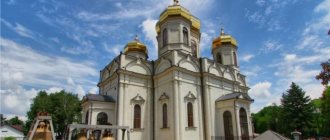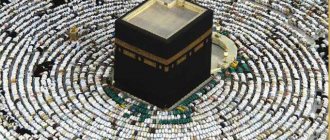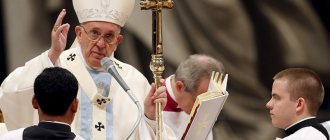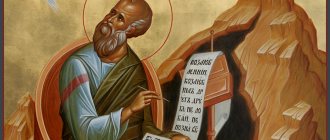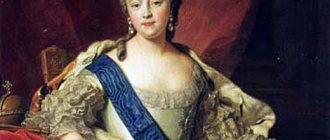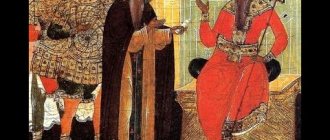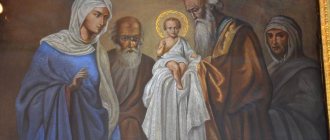| Damascus Assumption Cathedral. Photo November 3, 2010 |
Antiochian Orthodox Church
(or
Antiochian Patriarchate
), autocephalous local Church
- Official site:
- Canonical territory: Syria, Lebanon, southeast Turkey, Bahrain, Iraq, Iran, Yemen, Qatar, Kuwait, United Arab Emirates, Oman, Saudi Arabia; in the “diaspora” it is most represented in the countries of South America, also in the countries of North America, Western Europe, and Australia
- Liturgical language: Arabic and Byzantine Greek; in the “diaspora” Spanish, Portuguese, English, etc.
- Calendar: New Julian
- Cathedral: Assumption Cathedral in Damascus (also in Damascus and the patriarchal residence)
- Primate: John X, His Beatitude Patriarch of the Great City of God of Antioch, Syria, Arabia, Cilicia, Iberia and Mesopotamia and the whole East, Father of Fathers, Shepherd of Shepherds
- Place in diptych: 3
- Composition: 44 bishops; 22 dioceses; more than 408 clergy (ca. 2005) [1]; 496 parishes (ca. 2005) [2]; OK. 32 monasteries (early 2000s) [3]; 2 higher theological schools; 4.32 million members (2.5 million in South America, 1.25 million in the Middle East, 450 thousand in North America, 80 thousand in the rest of Asia, 40 thousand in Europe - ca. 2005) [ 2]
- On the map: Yandex.Map, Google map
Antioch is a strategically important village of the ancient world, where Christianity came under the influence of Rome
Antioch is an ancient village. It was founded 3 centuries before the birth of Christ. This was not a random idea, but a thoughtful strategic decision. Antioch had an advantageous geographical position.
Therefore, it was very quickly able to develop into a large and influential city, the capital of the state of the Syrian king Antiochus IV Epiphanes.
Antioch - the city where the Antiochian Church arose
But in 64 BC Antioch became part of the Roman Empire. Until the 2nd century, it retained its status as the second largest and most important city in Rome. It is difficult to overestimate its importance for the East. Antioch was called the capital of the Middle East.
Christianity came to Antioch under the influence of Rome.
Notes[ | ]
- Khulap V.F.
Reform of the calendar and Easter: history and modernity. - Metropolitan Hilarion (Alfeev), Archpriest Oleg Korytko, Archpriest Valentin Vasechko.
History of religions. - 2022. - P. 244. - Lisova N.N. Russian Church and Patriarchates of the East. Three church-political utopias of the 20th century // “Religions of the World. History and modernity" 2002. M.: Nauka. P. 150.
- On the restoration of the Arab patriarchate in the Patriarchate of Antioch Archived on August 13, 2007.
- Patriarchate of Antioch. // Government Gazette. - March 14 (27), 1913. - No. 59. - P. 4.
- Antiochian Orthodox Church. Patriarchy.ru
- American Protestants Find Their Home in Antiochian Orthodoxy (
October 5, 2009). - Greek Orthodox Patriarchate of Antioch and All the East The World Council of Churches.
- Kashitsyn I. D.
ARCHBISHOP OF BEREAN AMBROSY AND BISHOP OF SAFITE DEMITRIY - DIALOGUE ABOUT THE DIFFICULT LIFE OF SYRIAN CHRISTIANS // Christianity in the Middle East. - 2022. - No. 3. - P. 144-152. - doi:10.24411/2587-9316-2020-10023. - Official statement of the Patriarchate of Jerusalem on the jurisdictional affiliation of Qatar. sedmitza.ru, April 30, 2013.
- The Church of Antioch interrupted Eucharistic communion with the Patriarchate of Jerusalem. pravoslavie.ru, April 30, 2014.
- POSITION OF THE JERUSALEM PATRIARCHY REGARDING THE TERMINATION OF COMMUNICATION BY THE ANTIOCHE PATRIARCHY. Official website of the Jerusalem Patriarchate.
- The Patriarchate of Antioch ceases all communication with the Church of Jerusalem. pravoslavie.ru, June 29, 2015.
In Antioch, according to the book of Acts, for the first time not Jews, but pagans were converted to Christians
In the Bible, Antioch is mentioned in the book of Acts. The author writes that 7 deacons were elected for the church here. This was an unusual event, since the apostles had previously preached among the Jews, and Antioch was home to inhabitants of all kinds of cultures and peoples. For example, there are many Greeks.
Among the founders of the Antiochian Church, the apostles Peter and Paul are most often mentioned. But we also know about others:
- Barnabas;
- Luke of Cyrene;
- Manail;
- Simeon.
Together, these preachers created the Church in the East approximately 10 years after the crucifixion of Jesus Christ.
The New Testament reports that the apostles were successful in this activity. The author of Acts writes that many were converted to the Christian faith.
It is surprising that a young religion, actually still a sect based on Jewish teachings, could remain surrounded by ancient and influential creeds.
The word “Christians” was used for the first time in this city:
“For a whole year they gathered in church and taught a considerable number of people, and the disciples in Antioch for the first time began to be called Christians.”
(Acts 11:26)
It is curious that the Church of Antioch did not just reveal Christianity to the whole world. It became the first place where people who were not previously Jews were converted to the new faith.
This caused the first disagreements within Christianity. The issue was even discussed at the Jerusalem Council (around 50).
If Paul and his Faithful Companion Barnabas were among the founders of the Church in Antioch, then Peter most likely arrived there later. It seems that he was responsible for the last stage of the formation of the new Church. The apostle led for about seven years, after which he installed Saint Evoda as bishop.
Historical sketch
According to legend, it was founded about a year by the Apostle Paul and Barnabas in Antioch [4].
The bishop of this Church was the apostolic saint Ignatius the God-Bearer (+ century). Presbyter Lucian (+312) founded the famous Antiochian Theological School in Antioch, which contributed to the systematization of Christian dogmatic teaching and left a rich literary heritage. From the Antioch Church came the holy ascetics and defenders of Orthodoxy: St. John Chrysostom, who was born in Antioch and was a presbyter there before being called to the see of Constantinople; St. John of Damascus (+ c. 780), theologian who brought into the system the Christian teaching of the faith, church writer, defender of icon veneration; Venerable Hilarion the Great (+ c. 371), founder of monasticism in Palestine and the first mentor of the Antiochian monks, and many others.
At the First Ecumenical Council (in Nicaea, 325), the ancient tradition was confirmed, according to which the Bishop of Antioch was proclaimed the presiding bishop of his district. Then under the jurisdiction of Antioch were: Syria, Phenicia, Palestine, Arabia, Cilicia, Cyprus, and Mesopotamia.
After the Third Ecumenical Council (in Ephesus, 431), almost all eastern dioceses broke away from it and adopted Nestorianism.
At the IV Ecumenical Council (in Chalcedon, 451) it received the status of patriarchate, and the Patriarch of Antioch received priority of honor after the patriarchs of Rome and Constantinople. By decision of the same council, 58 of its dioceses were transferred to the Jerusalem Orthodox Church.
The condemnation of Monophysitism at the IV Ecumenical Council led to the division of the Antiochian Orthodox Church into two parts: those who remained faithful to Orthodoxy and those who leaned toward Monophysitism. Those who preserved Orthodoxy were called Melkites (from the word melk - emperor, i.e. supporters of the Byzantine emperor), those who accepted Monophysitism - Jacobites. The Orthodox predominated in the Hellenized coastal cities, the Monophysites in the smaller towns and rural areas of interior Syria. The contradictions that existed between the Greeks and the Semitic population of the Antiochian Patriarchate left their mark on the development of the Monophysite unrest. Control over the patriarchal see passed alternately from the Melkites to the Jacobites, and from 550 the Antiochian Church officially split into two parts: the Orthodox and Jacobite churches (the Jacobites still call themselves Orthodox).
In the period from 702 to 742. The Patriarchal throne of Antioch turned out to be vacant; the monks took advantage of this, honoring the hermit Maron as their patron, and formed their own Maronite Patriarchate of Antioch.
In 960, Byzantium again conquered Syria, after which the Melkite patriarchate was restored, adopting Byzantine rituals and the Orthodox canon.
After the conquest of Palestine by the crusaders and the formation of their states there, the throne (from 1199) was in exile in Constantinople. The Papists created the Latin Patriarchate of Antioch. After the liquidation of the Antiochian kingdom of the Crusaders, conquered by the Mamluks, in 1268, the Orthodox patriarchate was restored; the patriarch returned from emigration in 1269. due to the fact that the city of Antioch was almost completely destroyed, the patriarchal throne in 1342 or 1366 was moved to Damascus, where it remains to this day. In 1517, Damascus was captured by the Ottoman Empire and the Patriarch of Antioch again found itself under the leadership of Constantinople.
A new schism occurred in 1724, when the newly elected Patriarch Cyril VI recognized the primacy of the Pope and became a Uniate. The Orthodox Council removed him from his post and elected a new patriarch, but part of the church finally broke away and took the name Melkite Greek Catholic.
From 1724 to 1899, the highest clergy of the patriarchate was elected from the Greeks, but subsequently Arabs also began to receive the highest clergy, who eventually headed the patriarchate.
In 637, the Antiochian Church became dependent on the Arabs until the middle of the 10th century.
In 637, the Arabs captured Syria. This greatly shook the position of the Antiochian Church, because it had Greek patriarchs, and those, as enemies of the Arabs, had to go into exile to Constantinople.
Almost a hundred years passed before Caliph Hisham allowed the election of a monk from Syria to the See of Antioch. But this did not lead to anything good. The Arabs set very harsh and humiliating conditions, which the Church complied with without complaint.
For example, one of the patriarchs was forced to go with the Arab army to persuade the Byzantines to surrender instead of fighting.
The situation was corrected by the Byzantine emperor Nikiphon Phocas. He defeated the Arabs and expelled them from Antioch in the middle of the 10th century. Nominally, these became free lands again, but the local population continued to be unfriendly towards Christians, organizing pogroms and assassination attempts.
And yet the Church of Antioch was able to be revived.
Primates
[5]
- St. ap. Peter (about 45 - about 53)
- St. Evod (ca. 53 - ca. 68)
- sschmch. Ignatius I God-Bearer (c. 68 - c. 107)
- Iron (after 107 - approx. 136)
- Cornelius (c. 137 - c. 149) [6]
- Eros (ca. 150 - ca. 175)
- St. Theophilus (c. 176 - c. 188) [7]
- Maximin (c. 190 - ?) [8]
- St. Serapion (before 202 - after 211) [9]
- St. Asclepiades (212 - 220)
- Filit (Philet) (220 - 229/30)
- Zevin (229/30 – 235/6)
- sschmch. Vavila (238 - approx. 250) [10]
- Favius (251 - 253) [11]
- sschmch. Dimitrian (Dimitri) (c. 253-256 - c. 256-262)
- Amphilochius (?) [12]
- Paul of Samosata (c. 260 - deposed in 268 (272)) [13]
- St. Domnus I (c. 268 - c. 272) [14]
- Timaeus (274 - 283) [15]
- Cyril I (c. 279/280 - 303) [16]
- Tyrannus (c. 304 - c. 314) [17]
- Vitaly I (c. 314 - c. 320) [18]
- St. Phylogonium (c. 320 - 324) [19]
- St. Eustathius (324/325 - 330) [20]
- Peacock of Tyre (6 months in 330) [21]
- Eulaly (331 - 332 or 332 - 333), ruled for several months
- Euphronius (332 - 333)
- Flakill (Plakent) (333 - 342) [22]
- Stephen I (342 - summer 344) [23]
- Leonty (344 - 357) [24]
- Eudoxius (358 - September 359), Arian
- Anian (Ananius) (September 359)
Split - 360-392
- St. Meletius I (con. 360 - 381, with interruptions)
- Euzoius (360/361 - 376), Arian
- Peacock (362 - 388)
- Vitaly II (375 - ?)
- Dorotheus
(376 - 381?), successor of Euzoius
First Byzantine era - 395-637
- St. Flavian I (c. 381 – September 404), successor of Meletius
- Evagrius
(388 - 392/393), successor of Paulinus - St. Porfiry (404 - 414)
- Alexander I (414 - 424) [25]
- Theodotus (424 - 428) [26]
- St. John I (428 - 441/442)
- Domn II (Domnin I) (441/442 - 450)
- Maxim (451 - 455) [27]
- Basil I (ca. 457 - 458)
- Akakiy (458 - 459) [28]
- Martyrius (c. 459 - c. 470) [29]
- Peter II Knafey
(c. 469 - 471), Monophysite - Julian (471 - 475) [30]
- Peter II Knafei
(475 - 476), second time - John II Codonatus
(late 476 - early 477), Monophysite - Stephen II (spring 477 - 479) [31]
- John II Codonatus
(c. 480-481), re- - Kalandion (ca. 481 - 484)
- Peter II Knafei
(485 - 489), third time - John III (?)
- Palladium (490 - 498) [32]
- St. Flavian II (498 - autumn 512) [33]
- Sevier
, Monophysite (November 18, 512 – September 29, 518) [34] - Paul II (summer 519 - spring 521) [35]
- Euphrasius (spring 521 - May 26, 526)
- St. Ephraim IV or V (527 - 545)
- Sergius of Tell
, Monophysite (550s) - Domnus III (Domnin II) (545 - 559) [36]
- St. Anastasius I of Sinaiti (559 - 570)
- St. Gregory I (570 - 593)
- St. Anastasius I of Sinaiti (March 25, 593 - 598), again
- sschmch. Anastasius II of Sinaiti (beginning 599 - September 609)
- widowhood of the pulpit, c. 30 years
Era (from 661 - Umayyad) Caliphate - 637-750
- Macedonius (c. 639/640 - after 649) in Constantinople [38]
- George I (? - ca. 655) in Constantinople [39]
- Macarius I (c. 655 - March 8...April 5, 681) in Constantinople
- Theophanes (March 31, 681 - ?) in Constantinople [40]
- Thomas (? - ca. 685) in Constantinople
- Sebastian (?) [41]
- George II (c. 695 - c. 702) [42]
- Alexander II (?) [43]
- Stephen III (742 - 744) [44]
- Theophylact bar Kanbara (744 - 750) [45]
702-742 - widowhood of the department
Era of the Abbasid Caliphate - 750-969
- Theodore I (751 - ca. 773)
- Theodoret (c. 777 - c. 794)
- Widowhood of the see until 813 [46]
- Widowhood of the see until 953
Second Byzantine era - 969-1084
- Theodore II (January 23, 970 - May 29, 976)
- Agapius II (January 22, 978 - September 996)
- John III Politus (October 4, 996 – July 1021)
- Nicholas II (February 17, 1025 - November 7, 1030)
- Ilia II (April 1, 1032 - September 8, 1033)
- Theodore III (Lascaris) (March 3, 1034 - September 24, 1042)
- Vasily II (1042 - 1052)
- Peter III (after June 1052 - after August 1056)
- John (Dionysius) (1056 - until August 15, 1057)
- Theodosius III (Chrysoverg) (before August 30, 1057 - after 1059)
- Emilian (before 1074 - 1079/80)
Seljuk era - 1084-1098
- Nikephoros the Maurus (1079/1080 - ?) [48]
- John V (IV) Oxite (c. 1088/1089 - October 1100)
Latin era 1098-1268
- Theodosius IV?
- Aristarchus?
- John VI (V) Aplukhir (1106 - after 1134)
- Luke (1137/38 - 1156)
- Sotirich Pantevgen (1156 - May 1, 1157)
- Athanasius I Manasseh (1157 - June 22, 1171)
- Ilia III? (1182 - 1184)
- Christopher II (?) [49]
- Theodore IV Balsamon 1185-ca. 1203 [50]
- Joachim (I) ? [51]
- Dorofey (Hierofey) ? [52]
- Simeon II ibn Abu Shaib 1206-ca. 1240 [53]
- David (after 1240 - after 1247)
- Euthymius I (before 1258 - ca. 1277)
Mamluk (Egyptian) era - 1268-1517
- Theodosius V Villehardouin (c. 1277 - c. 1283/84) [54]
- Arseny I ca. 1284/1285-1285/1286
- Cyril II 26.IX.1287-1308
- Dionysius I ca. 1309-after 1316 [55]
- Kirill III?
- Dionysius II?
- Sophrony?
- John VI?
- Mark? [56]
- Ignatius II until Nov. 1344- to 1359, moved to Damascus [57]
- Pachomius I until 1359-1368, ??.VIII.1375-ser. 1377, ??.IV.1378-19.XII.1386 [58]
- Michael I 1368-17.VIII.1375 [59]
- Mark I ser. 1377-10.IV.1378
- Neil? [60]
- Nikon early 1387-11.I.1395
- Michael II 6.II.1395-8.IV.1412 (?) [61]
- Pachomius II 1.VI.1412-9.X.1412 [62]
- Joachim I ?-1425 [63]
- Mark II 1426/1427-? [64]
- Dorotheus I 1434/1435-8.IX.1451 [65]
- Michael III (Mark) 14.IX.1451-1456 (?) [66]
- Mark III c. 1456-1457/1458 [67]
- Joachim II before 20.VI.1458-after 1.VI.1459 [68]
- Gregory III? [69]
- Michael IV c. 1470…1474-up to 1484
- Dorotheus II ibn as-Sabuni before 1484-after 1500 [70]
Ottoman era - 1517-1922
- Michael V ibn al-Mawardi (before 1523/1524 - after July 1529)
- Dorotheus III (1529/1530 - 1530/1531)
- Joachim III (1530/1531 - until November 1534) [71]
- Michael VI Sabbagh (before November 10, 1534 - 1542/1543) [72]
- Joachim IV ibn Juma (c. 1543 - January 20, 1576) [73]
- Macarius II ibn Hilal
(c. 1543 - c. 1550) - Michael VII (before June 17, 1576 - ca. 1583)
- Joachim V (Dau) (25 May 1581 - 7 October 1592)
- Joachim VI ibn Ziyadeh (1593 - 1604)
- Dorotheus IV ibn al-Ahmar (1604 - 1611)
- Athanasius II (Dabbas) (1612 - February/March 1619)
- Ignatius III (Atiyah) (May 2, 1619 - late 1633/early 1634) [74]
- Cyril IV (Dabbas)
(May 2, 1619 - 1627) - Euthymius II (Karma) (1 May 1634 - December 1634)
- Euthymius III (December 1634 - November 11, 1647)
- Macarius III (al-Za'im) (December 12, 1647 - June 12 (?) 1672)
- Cyril V (al-Za'im) (2 July 1672 - 6 January (?) 1720)
- Neophyte Chiosets
(November 1672 - 1681/1682 [75]) - Athanasius III Dabbas
(June 25, 1685 or 1686 - October 1694)
- Kirill VI Thanos
(1724 — ?)
Modern era - since 1922
- Gregory IV (Haddad) (July 5, 1906 - 1928)
- Arseny II
(1928 - 1933), antipatriarch
- Epiphany
(1935), anipatriarch, heir of Arseny, rejoined the Synod
- Savva (Esber) (December 7 - 17, 2012) locum tenens, metropolitan. Bostrian
Turmoil forced the Church to move from Antioch to Damascus
In the 11th century, Christians made up almost half the population of Palestine and Syria. Everything seemed to be going well. Even when the Turkish Seljuks captured Antioch in 1084, this did not in any way affect the religious fate of the local population.
The invaders were somewhat uninterested in how the locals lived; they had other concerns.
But what really spoiled life for the Syrians were the divisions of territory, wars, the constant influx of foreigners and other echoes of political life.
At the end of the 11th century the crusaders arrived. Their appearance turned out to be much more harmful to the Christian population than the activities of the Turks.
The Crusaders inflicted enormous damage on the Church of Antioch.
Catholics began to expel Orthodox bishops and install their own clergy in their place. But they were unable to maintain their positions, and in the 13th century they left these lands.
If before the invasion of the Crusaders everything was more or less tolerant, then after their departure there were practically no Christians left. It was not possible to restore everything as before. In the 14th century, the department was moved to Damascus.
Current status[ | ]
Cathedral in Beirut, Lebanon.
Cathedral of St. George in Hama, Syria. The highest authority in the Patriarchate of Antioch belongs to the Holy Synod of 20 metropolitans. The Patriarch presides over the Synod. After the death of Patriarch Ignatius IV on December 5, 2012, the 167th primate of the Antiochian Orthodox Church, on December 17, 2012, a council of 18 hierarchs elected Metropolitan John of Europe (Yaziji), who became Patriarch of Antioch and All the East John X.
Currently, the Patriarchate of Antioch includes 22 dioceses[6]. Of these, six are in Syria:
- Antioch (Damascus)
- Verrian (Aleppo)
- Bostrian (Sveda)
- Laodicean (Latakia)
- Epiphanian (Hama)
- Emesa (Homs)
Six are in Lebanon:
- Beirut
- Arkadiyskaya (Halba)
- Biblskaya (Brummana)
- Iliupolskaya (Zakhla)
- Tyrian-Sidonian (Saida)
- Tripoli (Tripoli)
In addition: Baghdad, Kuwait, Arabian Peninsula and adjacent lands metropolitanate; eight dioceses on other continents, as well as the autonomous Antiochian Orthodox Archdiocese of North America. In the latter, since the end of the 20th century, there has been a significant increase in numbers due to conversion to Orthodoxy and the accession of other Christian denominations, mainly Protestant, to the Antiochian jurisdiction of the Americans[7].
The officially declared number of flocks is 4 million 320 thousand, of which 1 million 250 thousand people are in the Middle East[8]. Since Syria is a country with a majority Muslim population, the days off there are Friday and Saturday, which is why the Divine Liturgy is necessarily served in Orthodox churches on Fridays so that everyone can attend it. There is also the practice of serving the liturgy in the evenings, so that students and workers can participate in the service[9].
Due to a dispute between the Patriarchate of Jerusalem about jurisdiction over Qatar (in March 2013, the Patriarchate of Jerusalem appointed a bishop to the Qatari diocese established by it, which caused a protest from the Synod of the Patriarchate of Antioch [10][11][12]), the Synod of the Patriarchate of Antioch on June 27, 2015 adopted the final the decision to break “all ecclesiastical communion” with the Jerusalem Patriarchate[13].
The Ottoman Empire forced the Church of Antioch to pay taxes in the 16th century
The 16th century confronted the Church of Antioch with a new misfortune - the invasion of the Ottoman Empire. This ensured another humiliating period where Christians had to pay taxes for not being Muslims.
But it cannot be said that the Ottoman Empire was somehow hostile to Christianity. On the contrary, no persecution or attempts were made to convert everyone to Islam.
The maximum that the invaders allowed themselves was to arrest the Christian clergy in order to hurry them up with payments.
Literature[ | ]
- Panchenko K. A.
The Ottoman Empire and the fate of Orthodoxy in the Arab East (XVI - early XIX centuries). - M., 1998. - 160 p. — ISBN 5-88713-032-4. - Priest
Mikhail Nadzhim and T. L. Frazier, K. A. Panchenko, B. A. Nelyubov. Antiochian Orthodox Church // Orthodox Encyclopedia. - M., 2001. - T. II: “Alexy, man of God - Anfim of Ankhialsky.” — P. 501-529. — 752 p. — 40,000 copies. — ISBN 5-89572-007-2. - Antioch Councils // Orthodox Encyclopedia. - M., 2001. - T. II: “Alexy, man of God - Anfim of Ankhialsky.” — P. 530-534. — 752 p. — 40,000 copies. — ISBN 5-89572-007-2.
- Antiochian service (rite) // Orthodox Encyclopedia. - M., 2001. - T. II: “Alexy, man of God - Anfim of Ankhialsky.” — P. 534-535. — 752 p. — 40,000 copies. — ISBN 5-89572-007-2.
- Yakushev M.I.
The First Arab Patriarch on the Antioch Throne // Eastern Archive, 2006. - No. 14-15. - pp. 99-106 - Slyunkin A. A.
The Antiochian Orthodox Church and Russia: sources and historiography of relationships // Bulletin of Samara State University. 2010. - No. 75. - P. 125-133. - Kulikova K. E.
Antiochian Church: trends in ideological search // State, religion, church in Russia and abroad. 2010. - No. 2. - P. 23-32. - Kopot E.M.
On the question of the interpretation of the Greek-Arab confrontation and the influence of Russia in the Antiochian patriarchate in the second half of the 19th century. (based on materials from AVPRI) // Bulletin of Moscow University. Episode 13: Oriental Studies. 2011. - No. 3. - P. 31-38. - Kulikova K. E.
Antiochian Orthodox Church: pages of history and today // Bulletin of the Nizhny Novgorod University. N.I. Lobachevsky. - 2011. - No. 4-1. - pp. 299-311. - Slyunkin A.
A. Relations between Russia and Antioch in the 16th-17th centuries: the development of church-state ties. - Bryansk: RIO BSU, 2011. - 227 p. — ISBN 978-5-9734-0141-2 - Yakushev M.I.
Antioch and Jerusalem patriarchates in the politics of the Russian Empire = The Antioch and Jerusalem patriarchates in the politics of Russian Empire: 1830s - early 20th century; Foundation of the Holy All-Praised Apostle Andrew the First-Called. - Moscow: Indrik, 2013. - 534 p. — ISBN 978-5-91674-272-5 - Panchenko K. A.
Orthodox Arabs. The path through the centuries: collection. articles. - M.: PSTGU Publishing House, 2013. - 457 p. — ISBN 978-5-7429-0696-4 - Panchenko K. A.
On the history of the Antiochian Orthodox Church. XVII century: Patriarchal throne and clan solidarity // Bulletin of Church History. 2016. - Volume 1. - No. 1-2/41-42. — P. 159—196 - Panchenko K. A.
Northern Lebanese Orthodoxy at the dawn of the Ottoman era // Bulletin of the Orthodox St. Tikhon's University for the Humanities. Series 3: Philology. - 2022. - No. 53. - P. 55-76.
The meaning of Pelagia in Orthodoxy
Both Pelagia of Antioch are saints who lived at the dawn of Christianity and believed in Jesus Christ. Sincere faith in the Lord helped them save their souls and receive the protection of the Heavenly Father. Thanks to people like the two Pelagii from Antioch, Christianity took hold on earth. Believers lived according to God's commandments, and faith helped them survive any trials and difficulties.
Love for God came first for Pelagia (the virgin). The young Christian woman, without a moment’s hesitation, said goodbye to life, but did not betray religion. The virgin was not a martyr, but suffered for her faith in the Lord.
Pelagia (harlot) changed her life after hearing a sermon about the Savior. Words about God can heal the souls of the most hardened sinners and direct them to the path of salvation. The woman spent the rest of her life in a monastery, begging forgiveness for her sins. The harlot of Antioch changed herself and gave all Christians hope that faith in God is capable of miracles.
Using her own example, the saint showed believers how to beg God for forgiveness for sins. Having secluded yourself in a monastic cell, you need to pray day and night for the salvation of your soul. In addition to prayers, Christians are required to adhere to strict dietary restrictions, that is, to fast. Having renounced pleasures and spent their lives in prayer, Christians have the right to hope for forgiveness.
